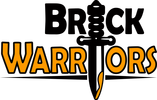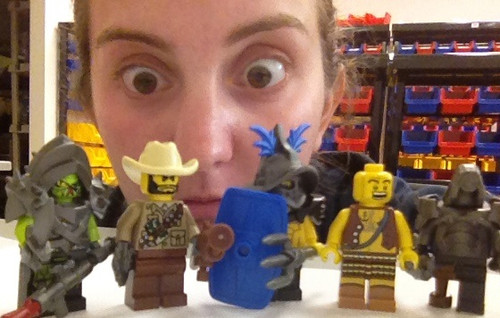The Brick Connection - Learning the Lingo 2: Learned and Fabulous
Posted by Cori on 17th Jun 2015
The Brick Connection – A novice Lego fan explores the great brick world of LEGO
Alright, who’s ready for Round 2 of Lego Lingo?
This round is all about the actual Lego products. I probably should have covered this first, but shoulda woulda coulda, who cares. And before you expert Lego fans get bored with me, remember, I’m not doing this blog to educate you, I’m doing it to amuse you.
Again, I would relate reading this blog as a Lego fan to my experience with a non-book-reading Harry Potter fan. (Who, in my opinion, should not really be able to call themselves a Harry Potter fan.) Me trying to explain Lego products to you is like one of them trying to name all the Weasley children. They know of them and they may know that there are a lot of them, but I bet they don’t know that one of them is named Charlie.
Back to Lego. Let’s start at the very beginning, a very good
place to start…
The Brick – a mysterious rectangular-shaped piece of plastic
that has controlled the minds of the young and old alike for decades.
"Lego Color Bricks" by Alan Chia - Lego Color
Bricks. Licensed under CC BY-SA 2.0 via Wikimedia Commons
They are the building blocks of Lego, literally and figuratively.
When you think of Lego, you think of the bricks. The bricks come in many
different colors and sizes, usually dependent on the number of studs and can
also come in non-rectangular form; e.g. a round brick.
Studs – unfortunately this is not referring to attractive young men who play with Lego. No, these are the very important bumps on the bricks that make it possible to connect one brick to another. Personally I enjoy my studs to be in male human form.
As I just mentioned, studs are used to measure the size of a
Lego brick. That’s funny, because I use studs to measure the size of a human...
…brick. Which I realize now is a very inefficient way to measure non-Lego objects. Wait, what did you think I was going to say?
Anyway, a Lego brick with a length of 4 studs down one side
and 8 studs down another equals a 4x8 brick. From what I understand, the
smaller number always goes first. I guess that’s how they do it in basic
construction too, but like most things I don’t care about, I don’t care.
That does explain that pesky Jumper term a little bit better to me. A jumper is a 1x2 modified plate. So 1 stud by 2 studs.
But wait, it’s a 1x2 modified plate with one stud. How can it be measured by 2 studs if it only has one???? You guys are screwing with me, aren’t you?
Well, did you non-book-reading Potter fans know that the
Marauder’s Map was created by Harry’s father James and James’s three best
friends Sirius Black, Remus Lupin, and Peter Pettigrew? Yeah, I didn’t think
so…
So there’s the brick, but there’s also the plate and the base plate….which both have studs, but are different from each other and from bricks.
You said it, Charlie!
Plate - these are thinner then bricks (but not as thin as
baseplates). Sure.
Apparently 3 plates on top of each other equal the height of one brick. Like a
brick, they can connect to other parts both on top and at the bottom. Which
leads to what makes a baseplate different…
Baseplate - These are thin plates that have no bottom connections. Which means a baseplate always has to be the bottom (or get this, the BASE) of a Lego structure, MOC, set, or whatever. They are large in surface area so there is room to build on them. The “footprint” of a MOC is the amount of space it takes up and it is usually measured in the number of baseplates
Not all baseplates are created equal though. While some are just regular one-color, studded, non-bottom connecting plates, others come with outlines of roads and bodies of water to give you something to build around. Some even have raised parts to give you some elevation to depict hills, rocks and the like.
Tiles – thin like plates, but while they connect to other studs, they have no studs on top. This allows for a nice smooth surface. Seems like a great way to make a nice tiled bathroom floor. That’s the kind of fun stuff people build with Lego, right?
Decorated Parts – bricks, plates, tiles, or other parts that have printed designs. Ooo! Maybe the bathroom floor can have seashells on the tiles!! So cute!
MOC – My Own Creation – a creation made with Lego, but not
with instructions. It’s just people using their own imaginations and some
connectable plastic bricks to do amazing things...
Of course sometime people’s imaginations are inspired by outside
ideas like, I don’t know, the fictional tale of a boy wizard.
(I think it’s
safe to say that this girl read the books.)
Diorama – a very large Lego scene. See above.
Vignette – a very small Lego scene, usually built on an 8x8 baseplate. (Oh my gosh, I know what that means!)
Bignette – a made up word that means big vignette. In
between a diorama and a vignette, but much closer to a vignette. So basically a
big small Lego scene.
My reaction to bignette
Minifigure – now were at the good part. A plastic figure
just over 1.5 inches tall with legs and feet designed to fit onto Lego studs.
And you know what are designed to fit onto Lego minifigures?? BrickWarriors
accessories!!
Visit us at BrickWarriors.com aka the website you’re already on.
Minifigures made their debut in 1974 and were comprised of 3 parts. A one-piece pair of legs, a one-piece torso with arms depicted as being in their pockets, and a head with no face. The head was the only part that could move.
Original Minifigures circa 1974
Now, as you know, there are movable legs and arms, heads with faces, and those classic Lego C-shaped hands, great for holding awesome BrickWarriors weapons and accessories.
Speaking of BrickWarriors accessories, here’s the next Lego
term:
Custom - a Lego creation or individual element that uses non-Lego parts or modified parts, or accessories from third-party vendors…like BrickWarriors!
People who like custom stuff are the antithesis to:
Purists – Someone who can’t think outside the box, aka someone who can’t appreciate a complement. And by complement I mean a complementary product to enhance an already great product.
Basically they can’t be bothered to use anything in their Lego-building that is not an official Lego product. Not one little thing.
I’m bored just thinking about it.
Speaking of non-Lego products…
Clones – basically Lego rip-offs. They are construction toys that are similar and sometimes compatible with Lego. Buying these products is comparable to buying your prescription drugs from that foreign woman who sells stuff out of a shopping cart behind the bowling alley. Or at least that’s something Lego fans would probably say.
Fun fact: Toy industry giant, Mattel Inc. acquired Mega Brands Inc., the company behind Lego’s most famous competitor, Mega Bloks, for $450 million last year. So I guess it’s not quite like that bowling alley lady.
Alright, let’s run down some final Lego terms for today
without being interrupted by my snarky commentary
BURP – big ugly rock piece. Not the normal brick shape. Funky looking; many different edges and sides.
SNOT – studs not on top. A creation where you can’t see the studs, only smooth surfaces. Tiles probably come in handy here.
POOP – “part of other parts” or “piece (that can be built) of other pieces.” It’s a complex element that could be made with a bunch of pieces, but Lego takes the work out of it by creating it as one whole piece. This is something that could be considered a BURP.
SNIR – studs not in a row. Studs are usually in a row, so it takes some creativity to make them not in a row. A jumper plate comes in handy here because with the one stud it has being in the middle of what should be a two stud plate, it can create a different alignment than a regular 1x2 plate. Check out the jumper plate in use below, which leads to some SNIR action
Greeble – detail added to an element to make it more
complex. The added detail doesn’t serve any function, but just improves
the overall look of the piece or MOC.
Fleshie – nickname given to minifigures with flesh-tones. These were introduced in 2004.
Bley – nickname for the bluish gray color that The Lego Group started producing for their pieces in 2003. I believe it’s supposed to be considered gray, but the Lego fans noticed the blue tinge and did not like it because it doesn’t match the previous gray color Lego produced. So they went with the nickname "bley" because it kind of sounds like “bleh.” You guys are a passive aggressive bunch.
WIP – work in progress. This could be referring to my life, but I think it’s something Lego fans say when they’re still working on a build or MOC
NPU – nice part use. I imagine people saying this like a beach blonde surfer dude: “Nice part use Brah!! Totally radical!! “ This is something you would say to someone or comment online to someone to compliment their excellent and creative use of a Lego part for a Lego build or MOC. Often it’s when someone uses a part differently from its intended use.
Phew! Done!
Believe it or not, there’s still a lot more stuff I could talk about, but I don’t wanna!
Instead let me give credit to my sources.
Minifigure info: http://lego.wikia.com/wiki/Minifigure
General Lego info: BrickiWiki
TMX Brick Notes Youtube Channel and website
The Brick Blogger - My new favorite Lego blog discovery. Has tips and tricks for building with Lego and provides some very helpful general knowledge.
This is where I found the most helpful definition of a Jumper Plate: http://www.brickwiki.info/wiki/Jumper_plate
And I think I finally have it figured out! The jumper plate is the size of a 1x2 plate, despite having only 1 stud. The stud's unusual position on a jumper plate allows the builder to be more creative and flexible, so to speak. They're not stuck with the rigid and stiff uniformity of regular Lego stud placement. They can break free from the Lego chains that bind them!!
I don't know, something like that. Feel free to explain it to me better...like I'm 10 years old..........no, like I'm 5 years old.
That's all for this Brick Connection. Coming up next week, it might be time for me to literally start connecting bricks. Or maybe we'll have one of those will they/won't they relationships. Is it true love?! Tune in next week to find out what happens next!
*Compliments, general feedback, and constructive criticism are welcome. Any haters that are gonna hate, hate, hate, hate, hate can go step on some Lego with their bare feet. *



